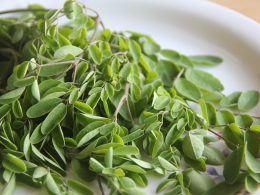The white swallowwort is a perennial herb native to the Mediterranean basin but it also grows in many parts of Europe, especially areas with warm weather.
The scientific name of white swallowwort is Cyananchum Vincetoxicum. This herb belongs to the Asclepiadaceae family and the underground rhizomes and roots are used for healing.
The root and rhizomes of this plant contain highly active medicine compounds and healing properties. Herbalists dry the roots and rhizomes of this plant at room temperature to maintain their active ingredients.
Some of the medicinal properties of white swallowwort are inducing vomiting, purgative, induce sweat, expectorant, and it is used to make a powerful tonic with diuretic and cleansing properties.
Some of the common conditions white swallow treat are swelling and bruising. It helps remove poisons and toxins from infected wounds. Swallowwort root is also taken to purify the blood and stimulate appetite.
Physical Description of White Swallowwort
You can find the swallowwort shrubs commonly in dry, barren, and high grounds. They easily grow in backyards and on roadsides. This perennial herb has many branches and their stems can be as 4 to 12 ft tall.
The stems of this plant are very soft and some parts of the pants have coverings like soft tissues/fur. White swallowwort also bears flowers which have many colors, they can be white, light purple, or violet.
The flowers grow in bunches and they have a unique aroma/scent. The fruits of white swallowwort are 2 to 3 inch long and 1 to 2 inch wide.
The fruits don’t have a definite shape as they can be egg-shaped, curved, oblong, or round. Swallowwort has a hot and bitter taste.
Other names for white swallowwort are:
- Greater Celandine
- Wartwort
- Yellow spit
- St. John’s wort
- Jacob’s ladder
- Garden calendine
- Calendine poppy
- Felonwort
- Chelidonium
- Milkweed
- Silkweed
- Indian Nosy
How Does Swallowwort Work?
The medicinal properties of this herb are based on its rich antioxidant content. It also has powerful antimicrobial and antiseptic properties that help in fighting infectious organisms.
Due to these, it has a high efficacy to handle many disorders.
Amazing Health Benefits of White Swallowwort
Ayurveda medicine (Indian traditional medicine) makes use of swallowwort a lot. Some of the uses of this potent the herb in Ayurveda and other types of natural medicine are:
1. Scabies
This is a skin infection caused by parasitic mites that burrow into the skin. This, in turn, causes intense itching and secondary skin infection. It is also highly transmittable from human to human.
Swallowwort is highly effective against this skin condition. You use it by cooking 10 grams of swallowwort milk in 50 grams of mustard oil.
Cook it until the milk is completely burnt and only the oil is left. Sieve and pour the solution in a bottle. Every day massage the affected part or your whole skin with this oil twice.
Use it three hours before taking your bath morning and evening. In a few days, you will cure this condition and restore your skin to normal.
2. Numbness
This happens when you have reduced or absent sensitivity to cutaneous stimulation. There are many ways herbalists use swallowwort for numbness, paralysis, and many more.
First method:
Fry 8 to 10 swallowwort leaves in 250 grams of oil. Use this oil to massage the affected body part or your whole body.
Second method:
Add swallowwort milk in a glass bowl and add Mal Kangani oil to it. Mix well and massage the patient with this mixture.
3. Rickets
This is a childhood disorder characterized by soft bones. It is mainly caused by vitamin D deficiency. To treat rickets using swallowwort, add 10 drops of swallowwort leaf extract to 30 mg of rock or sea salt.
Take this mixture. Note that it will induce vomiting and stooling and that is good for your digestive system. This will clean your system and improve the absorption of vitamin D and other nutrients from food.
4. Leprosy
This is an infectious disease caused by the bacterium Mycobacterium leprae. It affects the skin and can be transmitted.
Grind 2 grams of swallowwort root into solid and cook it in 400 grams of water until the water reduces to 50 grams. Drink this mixture once daily.
5. Heals wounds
Do you have any wounds from cuts, accidents, or falls? You can hasten healing by using this powerful herb.
Get a leafless branch of swallowwort and remove the peel. Take 40 to 50 grams of this peel and rub them to form a cake/paste. Heat this cake on a serving spoon and put it on the wound.
Tie it and leave it on the wound for a long time. Do this 2 to 3 times daily until the wound heals.
6. Eczema
This condition is noncontagious inflammation of the skin which can be acute or chronic. It is characterized by itching, redness, and the outbreak of oozing vesicular lesions which becomes scaly and encrusted.
This herb effectively treats all kinds of eczema. Mix equal quantities of honey and swallowwort milk. Apply this on the affected area to heal it quickly.
Another way to use this herb is to take 2 grams of swallowwort root powder and add it to 2 teaspoons of curd. Mix these properly and apply it on the affected area.
This is an excellent home remedy for eczema.
7. Paralysis
This condition is characterized by a complete loss of voluntary control over body parts. Paralysis can be managed with swallowwort and healing can come fast when mixed together with other herbs to get a synergetic effect.
Boil 500 grams of swallowwort root and boil it in 4 liters of water until 1 liter of water is left. Add equal quantities of peepal, cardamom, black pepper, liquorice powder, and sugar candy if needed.
Cook all these together on low heat and prepare a squash. Drink 1 to 2 grams of this squash it relieves abdominal disorders, pain in the legs and arms, paralysis, and many more.
8. Ascites
This condition is characterized by the accumulation of fluid in the peritoneal cavity of the abdomen, an important membrane lining the cavity of the abdomen. People with liver disease suffer from this condition.
Add 1 kg of swallowwort leaf juice to 20 grams of turmeric powder. Mix well and cook this mixture on low heat until it becomes thick that can make dough. Make gram-sized tablets.
Take 2 of these tablets twice daily.
You can also use a decoction of swallowwort instead of tablets. Mix 8 to 10 swallowwort leaves with rock or sea salt and burn this mixture in an earthen pot.
Take 250 mg ash with curd water three times daily. This powerful remedy relieves ascites and hepatomegaly.
9. Urinal problems
Swallowwort helps in relieving urinal problems and infections. Mix a little amount of Acacia tree root extract and swallowwort milk and apply this mixture around your belly button.
This cures a host of urinal problems.
10. Dyspepsia
This is a collection of disorder affecting the digestive system. It is characterized by nausea, heartburn, stomach pain, and other discomfort following a meal.
Treat dyspepsia by mixing equal quantities of swallowwort leaves, aloe vera pulp, and sugar. Cook these together until the sugar melts completely.
Allow the solution to get cool and then you pour it in a bottle for proper storage. Take 2 to 10 grams of this mixture when having dyspepsia.
Children from 6 months upward can take this potent remedy for dyspepsia.
11. Cholera
Cholera is an acute infection caused by the Vibrio cholerae affecting both humans and animals. It is transmitted through contaminated food and water and it causes serious gastrointestinal problems like diarrhea, dehydration, vomiting, nausea, abdominal cramps. Etc.
To treat cholera, mix 2 parts of swallowwort root bark and 1 part of black pepper. Grind them and sieve the mixture. Add ginger and onion juice to the mixture and form gram size tablets with them.
Take these tablets regularly to prevent cholera. Another way to treat cholera is to mix the following together: 10 grams of swallowwort buds, 5 grams each of borax, cloves, peepal, black salt, and ginger root.
Grind these to form tablets and take one tablet at short intervals or give it to the patient.
12. Jaundice
This is a morbid condition characterized by yellow eyes, skin, and urine. It is also accompanied by whiteness of feces, queasiness, constipation, loss of appetite, and general tiredness and slowness.
Mix 24 swallowwort root leaves with 50 grams of sugar. Blend these until you get a smooth mixture. Make gram shaped tablets with this mixture and take 2 to 3 tablets daily if you’re an adult.
An alternative is to mix the bark swallowwort with 12 pieces of black pepper and 2 to 3 grams of punarvana root. Grind all these in water and strain the water.
Take this mixture two times daily. Also remember to avoid unctuous, spicy, and hot food items.
13. Breathing problems
Respiratory infections can cause breathing problems and one powerful home remedy for this is the white swallowwort.
Mix 50 grams of swallowwort flowers with cloves and 6 grams of black pepper. Blend these together to make a fine paste. Make small pea-sized tablets out of this.
Take 1 to 2 tablets in the morning, use lukewarm water. This will help to control your breathing problems.
Another way to use swallowwort for respiratory problem is to use the soft stems and flowers of this potent herb. Blend them together to make a paste.
Try and get 2 to 3 grams of this paste and roast this mixture in ghee. Mix this with jaggery and take it every morning. Apart from treating breathing problems, it also helps treat cold, old cough, and phlegm mucous cough.
14. Migraine
A condition characterized by severe and disabling headache that affects only one part/side of the head. It is accompanied by visual disturbances, photophobia, vomiting, and nausea.
To treat migraine, take 10 grams of swallowwort root powder, (it must have been dried in a shade and not under direct sunlight). Mix this powder with 7 cardamoms, 500 mg each of peppermint and camphor.
Grind these into powder and store the mixture in a bottle. Take a tablespoon of this many times daily in warm water to relieve migraines and heaviness of the head.
15. Epilepsy
In this condition, the patient suffers from seizures (convulsions) and blackouts. It can be treated naturally and swallowwort can be incorporated into the holistic treatment for epilepsy.
Mix one part of swallowwort flower with 3 parts of old jaggery. Crush the flowers well and make sure they mix well with the jaggery. Make round pea-size tablets out of this.
Take 1 to 2 tablets two times daily.
A second method is to blend swallowwort flowers with black pepper and make tablets with this mixture. Take these tablets 3 to 4 times daily.
A third method is to mix swallowwort milk with little amount of powdered sugar. Take 125 mg of this mixture with 10 grams of hot milk every day.
16. Itching and hair lice
A lot of people face this condition but this potent herb discussed in this blog post can help relieve it.
Apply swallowwort milk on your head, leave it for 10 minutes, and then wash it off. This also cures dandruff, headache, moisture, and hair lice.
17. Eye problems
To relieve symptoms of eye problems and improve your vision, take a gram of swallowwort stem, crush it and soak it in 20 grams of rose water. Leave it to soak for 5 minutes and then strain the solution.
Use this solution as eye drops, put 2 drops two times daily in your eyes. This natural eye drop relieves heaviness of the eyes, eye pain, redness and irritation of the eyes, and excessive secretions.
An alternative is to burn swallowwort stem completely and use a little amount of the ash to make a smooth paste. Apply this around your eyes and on your eyelids.
This remedy effectively relieves puffy eyes, irritation of the years, swelling of the eyelids, and many more.
18. Scars and face marks
Do you have any scar or marks on your face or any body part that you’re not comfortable with? You can fade that mark with swallowwort.
Mix 3 grams of turmeric powder with rose water and swallowwort milk. Mix well and get a uniform mixture which you will apply on the affected skin area.
Make sure that the paste doesn’t get into your eyes. Apart from removing marks and scars, this paste can also give soft, toned, and glowing skin.
19. Relieves toothache
Tooth ache is a very painful condition that can stop one from sleeping or carrying on their daily activities. Dip a piece of cotton wool in swallowwort milk and smear it with ghee.
Place this cotton wool on the affected tooth to relieve pain and inflammation.
Another way to use this herb is to mix sea salt or rock salt in swallowwort milk and apply the mixture on an aching tooth. This powerful remedy offers fast relief.
A third way to use swallowwort for toothache is to take out a root of this herb, it should be thick as a finger. Roast it in fire till it turns to powder. Brush your teeth with this and also use the powder to get immediate relief from tooth pain.
20. Cataract
This disease of the eyes is characterized by a clouding of the lens in the eyes. This leads to a reduction in vision. Dip 10 grams of old brick powder in swallowwort milk and allow the mixture to dry.
Add 6 to 8 pieces of cloves to this and add rice to this dried paste. Inhale this every morning. Ayurveda practitioners believe this is a helpful cure for cataract.
Make sure the milk doesn’t get into your eyes as this can cause serious problems.
What’s The Right Dose of Swallowwort?
The appropriate dose of this herb depends on a lot of factors like your age, your health status, the disease you are treating, and other factor.
If using this herb or any of the recipes we posted in post, make sure you adhere strictly to the measurement. And always consult a professional before using this.
Always remember that you shouldn’t self-medicate with this herb, speak with a professional herbalist before using it.
Also, don’t combine it with medication drugs. You should also read the label and follow the instructions written on it.
Important Precautions and Warnings
Pregnant and breastfeeding women should avoid swallowwort. Don’t take swallowwort 2 weeks before your surgery since it slows down blood clotting.
If you take it close to your surgery, it might increase your chance of bleeding during your surgery or after it. This herb interacts with anticoagulant and antiplatelet drugs, and any drug or compound that slow blood clotting.
They are lots of misconceptions about this herb, a lot of people think it is poisonous for human consumption, well, this is partly true.
If you take swallowwort without the proper guidance of a trained herbalist or you take it in large doses, you can have problems like stomach disorders and even death.
However, it is a potent medicine and very safe if you take it under the direction and supervision of a knowledgeable natural healer. It can cure many diseases if used rightly.
We hope this post has given you a few uses of this powerful herb.
Sources;
- https://www.home-remedies-for-you.com/herbs/celandine-herb.html
- https://www.botanical-online.com/en/medicinal-plants/celandine-properties
- https://health-info.org/category/traditional-chinese-medicine/herbs/









